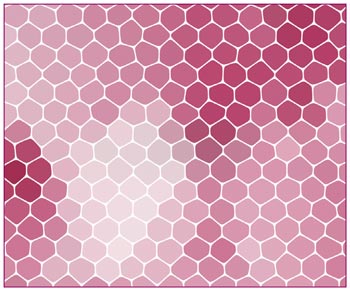 by Chankiat Songsantiphap, MD and Pravit Asawanonda, MD, DSc
by Chankiat Songsantiphap, MD and Pravit Asawanonda, MD, DSc
Drs. Songsantiphap and Asawanonda are with the Division of Dermatology, Department of Medicine, Faculty of Medicine at Chulalongkorn University in Bangkok, Thailand.
FUNDING: No funding was provided for this study.
DISCLOSURES: The authors have no conflicts of interest relevant to the content of this article.
ABSTRACT: Background. Performing objective measurements of skin oiliness requires a device that can directly measure the sebum level on the skin surface, while ultraviolet-induced red fluorescence (UVRF) can be used to indirectly assess the oiliness on the skin. There have been reports showing the association between these two methods in subjects with oily skin, acne-prone skin, but not in subjects with normal skin.
Objectives.We sought to study the association between UVRF and casual sebum level in terms of assessing the facial oiliness in individuals with normal skin.
Materials and Methods. Thirty subjects with normal skin were recruited for measurements of both casual sebum level and UVRF (porphyrin count) on specified areas of the face (i.e., forehead, nose, and cheek).
Results.There were very strong positive correlations with statistical significance in the areas of the forehead, nose, and cheeks (r=0.88, p<0.001; r=0.89, p<0.001; and r=0.95, p<0.001, respectively) when porphyrin counts in each area were compared to those of the whole face. Porphyrin counts were also positively correlated with the casual sebum level with statistical significance on the cheeks (r=0.43, p=0.02), while the forehead and nose showed more modest correlations without statistical significance (r=0.35, p=0.06 and r=0.36, p=0.05, respectively).
Conclusions. UVRF is correlated with casual sebum level. It might be useful for evaluating the facial oiliness of people with normal skin.
KEYWORDS: Fluorescence, oiliness, porphyrin, sebum, Sebumeter
J Clin Aesthet Dermatol. 2019;12(8):24–27
Oiliness of the skin usually depends upon the balance of skin hydration and the amount of lipids on the skin. Generally, the skin, especially on the face, is classified into three types: dry, normal, and oily.1 The facial lipid film consists of two parts: the epidermal lipids from keratinocytes and the complex mixture of lipids known as sebum, produced from the sebaceous glands.2,3 With available topical and systemic agents that can alter sebum contents within the follicles, it is important that objective measurements are available to evaluate these changes.
The Sebumeter® (Courage+Khazaka electronic GmbH, Köln, Germany) is a device that can directly measure the amount of lipids on the skin’s surface. This system relies on a direct photometric reading of lipids collected on a probe of plastic strip that turns transparent in proportion to the content of skin lipids. The values are then automatically calculated into micrograms of lipid per square centimeter for the specific area. Despite its usefulness, this device has some disadvantages. The preparation of the subjects before the procedure is necessary, which can be laborious. In addition, humidity and temperatures need to be closely regulated, which requires special set-ups that render it poorly suited for day-to-day clinical practice. Finally, the cost and the convenience of the device are to be considered.4–6
Currently, there exist other devices, available in several outpatient settings, that are easier to use than the Sebumeter and can indirectly measure the amount of facial skin sebum. One of these measurements relies on ultraviolet-induced red fluorescence (UVRF) from coproporphyrin III produced by Cutibacterium (formerly, Propionibacterium) acnes in the sebaceous glands, which thrives on sebum. Therefore, this fluorescence might reflect the amount of sebum in the hair follicles. Although some reports have suggested the association between UVRF and the surface lipids on facial skin, these studies were conducted only in subjects with acne-prone or oily skin.7
To date, there have been no studies conducted using UVRF in subjects with normal skin, which led us to study the correlation between UVRF and direct casual sebum measurements in this population. As our secondary research objective, we sought to identify possible differences in measurements that were recorded from different parts of the face.
Materials and Methods
The study was conducted in accordance with the Declaration of Helsinki and the protocol was approved by the Institutional Review Board of the Faculty of Medicine, Chulalongkorn University in Bangkok, Thailand (approval no. 511/60). All subjects were recruited at the research center (SURFACE) of the Dermatology Division, Faculty of Medicine, Chulalongkorn University and were informed regarding objectives and methods of the study. Signed informed consent forms were gathered prior to enrollment.
Subjects. Subjects older than 18 years of age with clinically normal skin type were eligible. Subject skin type was evaluated through a subject-reported questionnaire and the investigator assessment. The questionnaire was created to classify facial skin type into three groups: dry, normal, and oily. Combination skin was included within the normal-skin type.Subjects who had any facial dermatoses (e.g., atopic dermatitis), acne (Leeds grade >2), a history of smoking, or were taking any hormonal therapy, such as contraceptive pills or androgen agonist/antagonist medications, were excluded.
Study design. This study was performed under controlled climatic conditions. The room temperature was maintained at 22°C±2°C and the relative humidity was maintained at 50%±5%. A pre-enrollment wash-out period of one month was required for subjects who used exfoliating agents, including topical retinoids, peeling agents, or topical antibacterials. Oral retinoids had to be discontinued for at least six months prior to inclusion. All subjects were asked to avoid the application of topical preparations, such as cosmetics or sunscreen, on the face within four hours of the measurements. At the visit, each subjects washed their face with a provided cleanser (Neutrogena, Johnson & Johnson, New Brunswick, New Jersey), dried the face, and acclimatized in the control room for at least 45 to 60 minutes. Next, the UVRF measurement and the casual sebum level measurement were performed by the same investigator (CS). All data, including the characteristics from the subject questionnaires, were recorded in the case record form.
Measurement of UVRF. After acclimatization, Visia® (Canfield Scientific, Inc., Parsippany, New Jersey) was used to capture the facial image with add-in software to analyze the UVRF spots. Four separate images of each subject’s face were taken to analyze four facial areas, which included the whole face, forehead, nose, and left cheek (Figure 1). Each area was manually mapped by the principal investigator (CS), with the exception of the whole-face image, which was automatically generated by the software. Porphyrin counts represent the UVRF results.
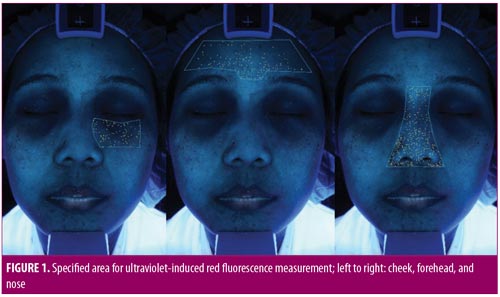
Measurement of casual sebum level. This step was performed immediately after the UVRF measurement. The Sebumeter® (SM810 PC; Courage+Khazaka Electronic GmbH, Cologne, Germany) was used to measure the sebum amounts in the same three facial areas, as follows: forehead (mid-glabella), nose (nose tip), and left cheek (over the zygoma at the midpupillary line). The investigator handled the probe with a plastic strip placed perpendicular to the skin with constant pressure for 30 seconds. After, the probe was placed back into the main port. The photometry system determined the transparency of the strip after contact with the lipids on the skin surface and displayed the sebum amount in micrograms per square centimeter.
Sample size and statistical analysis. To determine the correlation between the UVRF and Sebumeter® readings, assuming a power of 90 percent and a five-percent, two-sided, type I error with minimal impact correlation at 0.5, 30 subjects were required for this study. Baseline characteristics were summarized using descriptive statistics. Pearson’s correlation was used to study the correlation between casual sebum level and UVRF. We also used a linear regression model to find the predicted sebum level from porphyrin counts. Sebum levels and UVRF of the three areas were compared using one-way analysis of variance. A two-sample independent t-test was used for the comparison of sebum levels and porphyrin counts between male and female subjects. All statistical analyses were done using the Stata version 13.1 software program (StataCorp LLC, College Station, Texas). Data are expressed as means±standard deviations (SDs) and the difference was considered statistically significant when p<0.05.
Results
Characteristics of participants. Thirty subjects, including 18 men (60%) and 12 women (40%) with a mean age of 22.3±1.0 years were recruited for this study. Twenty-four subjects (80%) washed their faces twice a day. Interestingly, cleansers were never (40%) or occasionally (40%) used during the face-washing. The oiliest area on the face reported by subjects was the nose in 21 subjects (70%), while the cheek was the least oily area. Furthermore, the sweatiest area on the face was the temple in 15 subjects (50%). The characteristics of the study participants are shown in Table 1.
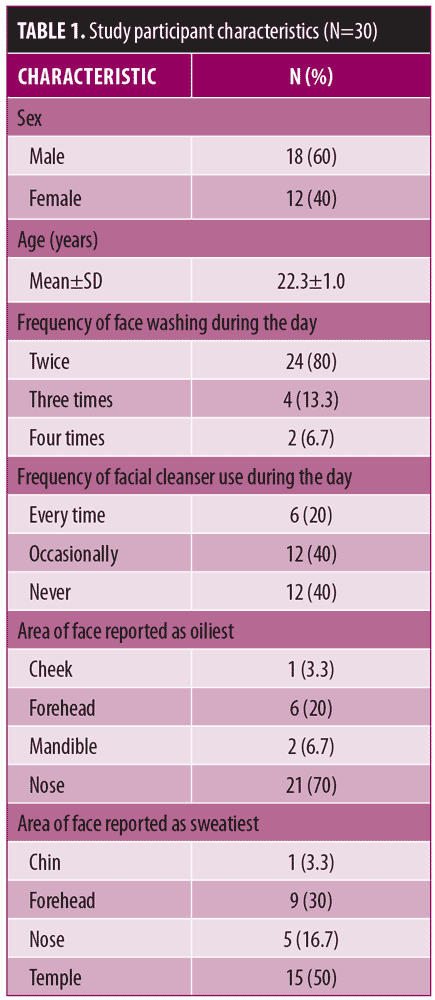
Casual sebum levels in different areas of the face. The casual sebum levels between male and female subjects were statistically significantly different in the cheek area (Table 2). The mean±SD sebum amounts in different areas of the face were as follows: forehead, 58.2±27.2 ug/cm2; nose, 95.7±42.9 ug/cm2; and left cheek, 34.8±21.5 ug/cm2. It is not surprising that the nose had the highest values for sebum level; these were significantly higher than those for the forehead (p<0.001) and the forehead sebum levels were, in turn, significantly higher than those of the cheek (p=0.005).
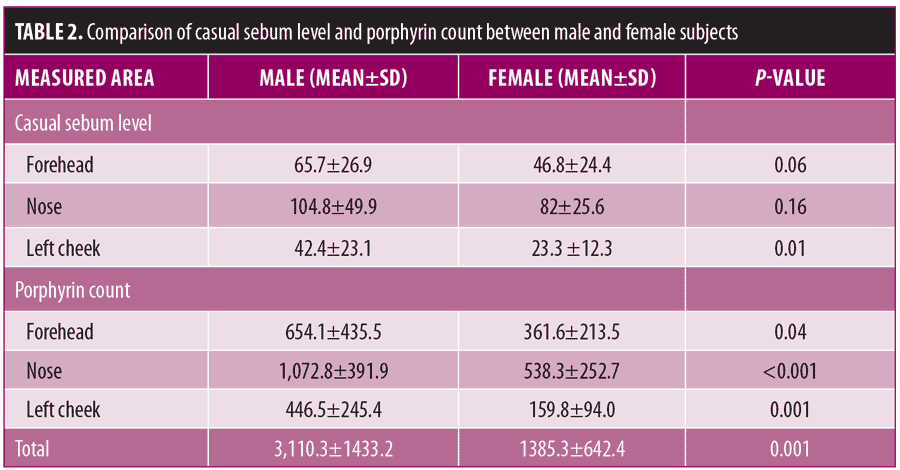
Porphyrin counts in any given area represent the whole face. We studied the correlations between the porphyrin counts of different areas and total porphyrin count of the whole face. Of note, the mean UVRF counts were significantly higher in male subjects for all three areas (Table 2). The mean UVRF±SD values were 537.1±386.9 for the forehead, 859±430.3 for the nose, 331.8±243 for the left cheek, and 2,420.3±1,448.9 for the whole face. Again, the nose had the highest values for UVRF, similar to in the case of sebum level. Interestingly, there were very strong positive correlations with statistical significance when porphyrin counts on the forehead, nose, and cheek (r=0.88, p<0.001; r=0.89, p<0.001; and r=0.95, p<0.001, respectively) were compared with the porphyrin count of the whole face (Figure 2). The UVRF for the nose was significantly higher than that of forehead (p=0.001) and that of the forehead was higher than that of the cheek (p=0.001).
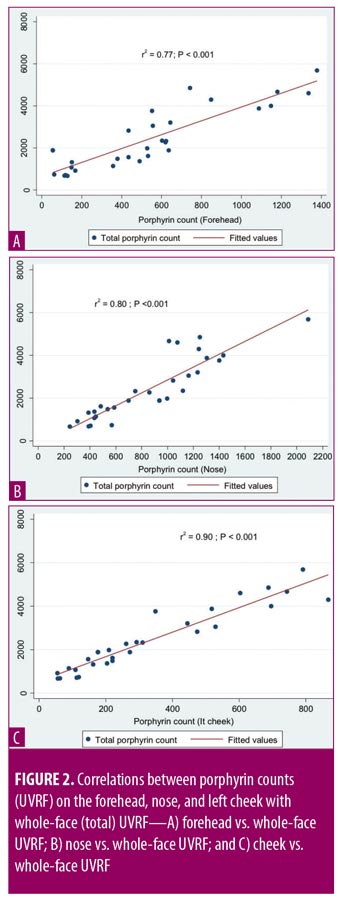
Porphyrin counts show correlations with casual sebum level. Porphyrin counts were positively correlated with casual sebum level at all three sites of interest. However, the correlation reached statistically significant levels only on the cheek (r=0.43; p=0.02). The forehead and nose also showed some degree of positive correlation, with trends towards statistical significance (r=0.35; p=0.06 and r=0.36; p=0.05, respectively) (Figure 3).
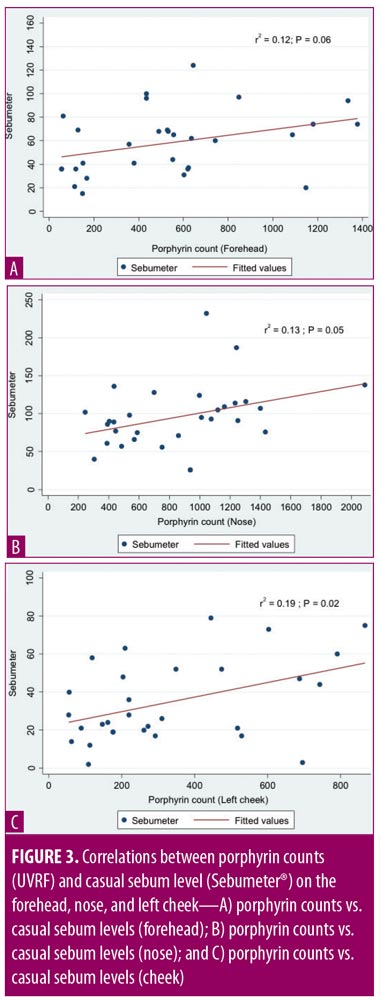
Discussion
Performing measurements of both sebum content within the sebaceous glands and on the skin surface is time consuming and difficult. As such, in studies that investigated the effects of topical acne treatments, UVRF, which measures porphyrin counts produced by C. acnes, is often used as a surrogate measure. To our knowledge, most of these were conducted in subjects with acne-prone and/or oily skin, where the sebum levels tend to be high.6,8 It has also been reported that this measurement can be used to indicate acne severity.9 Recently, a study reported that UVRF was more directly correlated with sebum secretion than the presence of C. acnes.7 For this reason, we hypothesized that UVRF might be useful to assess the oiliness or sebum production of the face in subjects with normal skin.
The first major conclusion from our study was that UVRF in any of the three areas we measured showed a very strong correlation with the values obtained from the entire face. This has important clinical implications, as it would allow for a comparison of topical preparations that might reduce sebum production in a split-face manner. It is also worth mentioning that washing the face did not alter the UVRF detection, which adds more value to the robustness of this test (data not shown).
In this study, we also demonstrated that UVRF had a positive correlation with the casual sebum level in subjects with normal skin, with statistical significance in the cheek area (r=0.43; p=0.02). This leads us to propose that cheek UVRF detection might represent the skin’s oiliness, at least in normal-skin individuals. Whether this is true for excessively oily or dry skin types remains to be investigated. There are several factors that might help explain the correlation, or lack thereof, between porphyrins and casual sebum level on the skin surface, apart from the fact that the surface lipids are derived from more varied sources. Porphyrins are produced by many species of bacteria, especially Corynebacterium spp. UVRF is therefore affected by the diversity of microbiotas on the skin and within the hair follicles.10 Despite the vast expansion of knowledge regarding variations in microbiotas in different areas of the body and in different skin diseases, to our knowledge, very little is known about the diversity of microbiotas in different areas of the facial skin. Also, the production of sebum and surface lipids is under the control of a person’s hormonal, neurological, and immunological systems, and even their diet to a different degree. Moreover, age, sex, and stage within the menstrual cycle might be important in the complex interplay of these factors.2,3
Another point worthy of note is that the mean sebum level on the nose was quite high, at 95.7±42.9ug/cm2, compared to the Sebumeter® manufacturer’s values of 33 to 66ug/cm2 in the normal skin type.11 We assumed that this was due to differences in ethnicity and climate, even though a strict acclimatization protocol was exercised. This emphasizes that measurements need to be performed in each specific population.
Limitations. The strengths of our study are, first, the use of two very objective and reproducible measurements. Second, we employed the agreement between a clinical evaluation from a dermatologist and a subjective assessment questionnaire that was built and modified from the validated oiliness questionnaire to classify skin type for our population. However, there are some limitations worth mentioning here. Due to a low degree of positive correlation, we could not conclude that UVRF could replace casual sebum measurement in individuals with normal skin. Whether this is different in other skin types remains to be studied further. Also, some parts of the face, such as the chin, were not included in this study due to the limitations of the device. However, according to the questionnaire, the chin area did not stand out as the oiliest point. Finally, our subjects were of a narrow age range (15–25 years), within which high sebum production activity is normally noted. Although this could strengthen our results, our findings might not be generalized to other age groups.
Conclusion
This study demonstrated that UVRF in any of the three areas studied—the forehead, nose, and cheek—showed very strong correlations with the values obtained from whole-face measurements in Thai subjects with normal skin. Male subjects demonstrated higher sebum contents, both as detected by casual sebum level and UVRF, than their female counterparts. There is some degree of correlation between UVRF and casual sebum level. Larger sample sizes and a greater variety of age groups should be considered in future research.
References
- Baek JH, Lee MY, Koh JS. Relationship between clinical features of facial dry skin and biophysical parameters in Asians. Int J Cosmet Sci. 2011;33(3):222–227.
- Sakuma TH, Maibach HI. Oily skin: an overview. Skin Pharmacol Physiol. 2012;25(5):227–235.
- Daniel F. [The seborrheic skin]. Rev Prat. 1985;35(53):3215–3224. Article in French.
- Blanc D, Agache P. Sebum excretion. Methods of measurement and influence of physical factors. Int J Cosmet Sci. 1980;2(5):243–250.
- Kligman AM, Shelley WB. An investigation of the biology of the human sebaceous gland. J Invest Dermatol. 1958;30(3):99–125.
- Choi CW, Choi JW, Park KC, Youn SW. Ultraviolet-induced red fluorescence of patients with acne reflects regional casual sebum level and acne lesion distribution: qualitative and quantitative analyses of facial fluorescence. Br J Dermatol. 2012;166(1):59–66.
- Youn SW, Kim JH, Lee JE, et al. The facial red fluorescence of ultraviolet photography: is this color due to Propionibacterium acnes or the unknown content of secreted sebum? Skin Res Technol. 2009;15(2):230–236.
- McGinley KJ, Webster GF, Leyden JJ. Facial follicular porphyrin fluorescence: correlation with age and density of Propionibacterium acnes. Br J Dermatol. 1980;102(4):437–441.
- Richter C, Trojahn C, Dobos G, et al. Follicular fluorescence quantity to characterize acne severity: a validation study. Skin Res Technol. 2016;22(4):451–459.
- Byrd AL, Belkaid Y, Segre JA. The human skin microbiome. Nat Rev Microbiol. 2018;16(3): s143–155.
- Youn SW, Kim SJ, Hwang IA, Park KC. Evaluation of facial skin type by sebum secretion: discrepancies between subjective descriptions and sebum secretion. Skin Res Technol. 2002;8(3):168–172.

